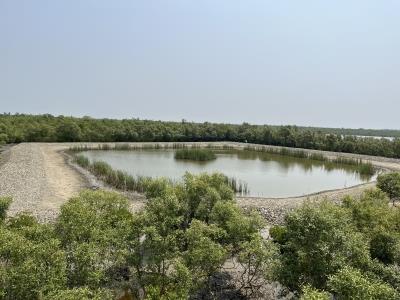(MENAFN- IANS)



By Nishant Arora
Sundarbans (West Bengal), March 27 (IANS) Home to the Royal Bengal Tiger and an ecologically unique biodiversity, the worlds largest mangrove forest is now bearing the brunt of both climate upheavals and unabated human greed, leaving the World Heritage Site gasping for life.
Locals here lament that in the past couple of years, several islands have turned into a concrete jungle, with new plush resorts and other real estate structures now distinctively disturbing the natural landscape.
This, coupled with massive cyclones that devastated Sundarbans forests in recent years, has left the inhabitants of 54 islands (out of a total of 102; rest being reserve forests) in constant fear of losing their livelihoods, and lives.
'The construction of embankments as a buffer against natural disasters is not yet complete in several islands. On the other hand, rampant real estate development to squeeze in more tourists has put our islands in further danger,' Sayantan, 30, told IANS.
Out of nearly 10,000 sq km that these mangrove forests cover, a little over 4,000 sq km is in India and the rest is in Bangladesh. In 1987, the Sundarbans National Park was designated as a World Heritage Site by UNESCO.
Home to over 4.5 million people and many rare and globally threatened wildlife species, like the estuarine crocodile, water monitor lizard, Gangetic dolphin and Olive Ridley turtle -- not to forget the Royal Bengal Tiger whose number rests at 96 on the Indian side of the Sundarbans as per counting last year -- the low-lying islands are facing an existential crisis.
In May 2020, the massive cyclone Amphan ravaged a large part of the deltaic Sundarbans region, displacing thousands of residents of the islands.
The agricultural lands and all water bodies were filled with saline water and people who earned their livelihood through vegetation, fisheries and cattle farming landed in deep trouble.
Last May, Cyclone 'Yaas' caused severe damage to the Sunderbans Tiger Reserve, and inundated breeding centres for crocodiles and a rare species of turtle.
The mismanagement of the modern embankments has led to salt water entering agricultural lands, making them unsuitable for cultivation, according to locals.
Moreover, nylon net fencing or natural barriers to prevent tigers from entering human habitations were heavily damaged during the storms, and the damage can still be seen at several places.
The straying of the Royal Bengal Tigers into villages has not stopped and the famous 'maneaters' of Sundarbans now roam freely and attack humans as their own habitats are being lost to climate change and human intervention.
According to a local guide Sanjib, the nylon net fencing is not working anymore to keep tigers away from human-inhabited islands as they are not afraid of this fencing anymore.
'Their brains are now adapted to this whole new world where net fencing is no more a threat to them. They easily cross those fences, left open by fishermen and people who enter 'core' forest zones for catching crabs/prawns and honey collection. Tigers have also been drinking saline water for years which has messed up their bodies,' Sanjib told IANS.
The latest media reports say that some 43 crab catchers fell prey to tiger attacks in the last seven months in the Sundarbans.
Locals fear that one day the delta may disappear from the face of the Earth if realistic steps are not taken.
The tiger attacks have risen manifold in West Bengal and the loss of tiger habitat is given as the key reason for the man-animal conflict.
To tackle the erosion of natural barriers, the West Bengal government now plans to construct a robust and ecologically sustainable 'bio-shield' along the state's coastline and the Sundarbans islands.
The plan is to build earth embankments, plant 36 species of resilient mangrove species and set up a geo-textile cover on embankments, and a second line of embankments on the east-facing concave coastline, where erosion is highest.
The impact of climate change is most severe in the Bengal delta region, where the sea level rise is the highest globally.
The global mean sea level has been rising at 3.6 mm per year between 2006 and 2015. The sea level off the coast of Bengal is rising at around 4 mm per year, according to the latest reports.
The Sundarbans is carved out of two West Bengal districts -- South 24 Parganas and North 24 Parganas. The alluvial archipelago is formed by 56 riverine islands.
Considered to be one of the richest but most fragile ecosystems on the planet, the Sundarbans delta, formed by the myriad branches of the Ganga, has forest tracts that reach 130 km inland from the coastline.
(Nishant Arora can be reached at )
--IANS
na/bg
MENAFN27032022000231011071ID1103919504
Legal Disclaimer:
MENAFN provides the information “as is” without warranty of any kind. We do not accept any responsibility or liability for the accuracy, content, images, videos, licenses, completeness, legality, or reliability of the information contained in this article. If you have any complaints or copyright issues related to this article, kindly contact the provider above.